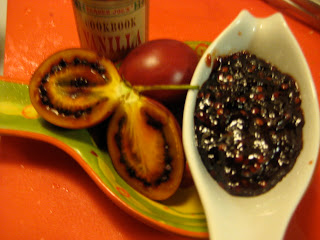
Locally grown and harvested in the Mission District neighborhood of San Francisco.
Background information:
The tamarillo is generally believed to be native to the Andes of Peru and probably also, Chile, Ecuador and Bolivia. It is cultivated and naturalized in Argentina, Brazil, Colombia and Venezuela. It is widely grown in New Zealand as a commercial crop. Seed from Argentina were imported by the U.S.Dept. of Agriculture in 1913 and a plant was fruiting at the Plant Introduction Station at Chico, Calif. in 1915.
Ecuadorian Orange
Fruit is medium orange in color, the size of a large hen's egg. Pulp light orange, creamy in texture, less acid than the Ruby Red. Excellent for eating out of hand and also suited for culinary purposes.GoldmineA superior cultivar originating in New Zealand and recently introduced. Very large golden-yellow fruit with golden, highly flavored flesh, less bland than Solid Gold, but not acidic. Has superb earing qualities.Inca GoldA yellow-fruited cultivar said to be less acid than the red types. When cooked the fruit is said to resemble the apricot in flavor.Oratia RedA large fruited red cultivar, oval to rounded in shape, with a sharp acid flavor. Good quality for eating out of hand and excellent for jams and preserves.RothamerUnusual large fruit, over 3 ounces. Skin bright red. Flesh golden-yellow, flavor sweet and exotic. Seeds dark red. Ripen from December to April. Delicious eaten out of hand. Vigorous and heavy bearing plant. Originated in San Rafael, Calif.Ruby RedLarge, brilliant red fruit. Pulp dark red, tart and flavorful. Fair for eating out of hand, but very good for culinary use. If allowed to ripen for one to three weeks after picking, they will become less acid. The standard cultivar grown for export in New Zealand.Solid GoldLarge, oval shaped fruit. Skin golden-orange in color. Pulp soft, less acidic in flavor than Oratia Red. Very good for eating out of hand, with acceptable culinary qualities.YellowFruits the size and shape of a large plum. Skin yellowish orange. Flesh yellow, with a milder flavor than the red types. The yellow form is the oldest in cultivation in New Zealand.
 My neighbors John and Richie has a tree in their backyard for over 12 years and so kind of them to give a basket full of Tamarillos this year. Thus, I had decided to make Tamarillo Jam for the first time instead of using it for my morning smoothies.
My neighbors John and Richie has a tree in their backyard for over 12 years and so kind of them to give a basket full of Tamarillos this year. Thus, I had decided to make Tamarillo Jam for the first time instead of using it for my morning smoothies. About a year ago, I had tried this fruit out and did not like it because the tomato taste overpowered my palate. I wanted to try out a different way beside eating the fruit itself. So I went with the idea of making jam out of it and to reduce the tomato taste. While in the process of turning this redish hard skin fruit into jam, which I had discovered the tamarillo was cross-over between a passion fruit and tomato. With it black harden seeds, yellowish flesh, and tomato texture/scent really brought out my culinary curiosity. Attempted to experiment with this wonderful fruit, which I had stepped up to the plate and jumped right into my kitchen and then went JAM crazy. Going to show you step by step how my culinary skills went into full effect of creating an awesome Tamarillo Jam.
Steps to making tasty and delicious Tamarillo Jam
To be continue...
Thanks for reading
Chantica aka Sao Laomerican
 Used pre-made GF crust from Whole Foods, real cocoa powder, cage free eggs, organic plain yogurt, turbinado raw sugar, 365 degree cream cheese, and used the blender beside the food processor.
Used pre-made GF crust from Whole Foods, real cocoa powder, cage free eggs, organic plain yogurt, turbinado raw sugar, 365 degree cream cheese, and used the blender beside the food processor.







